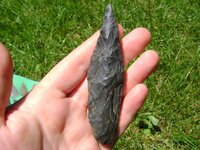Th3rty7
Silver Member
Recently purchased a frame of Pa points, made from flint, jasper, quartz and shale. Some of the types look familiar but Pa seems to have alot of unique types. The largest point on the right is a Meadowwood I think, about the only point in the frame I'm familiar with. If any could help me ID these I'd appreciate it.
Upvote
0






